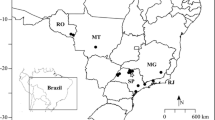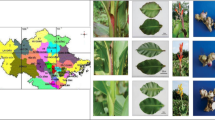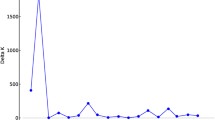Abstract
Campomanesia phaea (O. Berg) Landrum (Myrtaceae), known as cambuci, is a native species from the Brazilian Atlantic Forest with great potential to be developed as a new fruit crop. Microsatellite markers were developed for cambuci to characterize the genetic diversity and to investigate the genetic structure of a group of accessions originally collected at the presumed center of the species diversity. This work involved the collection of 145 accessions from five regional groups (Juquitiba, Paraibuna, Mogi das Cruzes, Ribeirão Pires, and Salesópolis) in São Paulo state, Brazil. Fourteen loci were identified in an enriched genomic library developed from one of these accessions. Six of the 14 loci were polymorphic, disclosing 26 alleles. Based on the allele frequencies, the calculated genetic parameters of the five groups indicated an average allele number per locus (A) of 3.83, with an expected heterozygosity (He) of 0.57 and observed heterozygosity (Ho) of 0.54. Analysis of the genetic structure indicated that most of the genetic diversity was found within population (HS = 0.57), whereas the genetic diversity among populations was low (GST = 0.19). The genetic diversity parameter of Nei was considered low for the cambuci analyzed populations, with no evidence of inbreeding. Based on Darwin analysis, 18 accessions were chosen from the five regional populations to compose a core collection that included most of the genetic diversity found in this study. Our findings may contribute to defining better conservation strategies and genetic breeding approaches for this native species in Brazil.


Similar content being viewed by others
Availability of data and material
The datasets of the current study are presented in this article or are available upon a reasonable request.
References
Alves RM, Sebbenn AM, Artero AS, Clement C, Figueira A (2007) High levels of genetic divergence and inbreeding in populations of cupuassu (Theobroma grandiflorum). Tree Genet Genomes 3:289–298. https://doi.org/10.1007/s11295-006-0066-9
Anderson JA, Churchill GA, Autrique JE, Tanksley SD, Sorrells ME (1993) Optimizing parental selection for genetic linkage maps. Genome 36:181–186. https://doi.org/10.1139/g93-024
Bernard A, Barreneche T, Lheureux F, Dirlewanger E (2018) Analysis of genetic diversity and structure in a worldwide walnut (Juglans regia L) germplasm using SSR markers. PLoS One 13:e0208021. https://doi.org/10.1371/journal.pone.0208021
Bianchini FG, Balbi RV, Pio R, Silva DF, Pasqual M, Vilas Boas EVB (2016) Caracterização morfológica e química de frutos de cambucizeiro. Bragantia 75:10–18. https://doi.org/10.1590/1678-4499.096
Bianchini FG, Balbi RV, Pio R, Bruzi AT, Silva DF (2017) Parents choice and genetic divergence between cambuci fruit tree accessions. Crop Breed Appl Biotechnol 17:214–220. https://doi.org/10.1590/1984-70332017v17n3a33
Billot C, Ramu P, Bouchet S et al (2013) Massive sorghum collection genotyped with SSR markers to enhance use of global genetic resources. PLoS ONE 8:e59714. https://doi.org/10.1371/journal.pone.0059714
Billotte N, Lagoda PJL, Risterucci AM, Baurens FC (1999) Microsatellite-enriched libraries: applied methodology for the development of SSR markers in tropical crops. Fruits 54:277–288
Botstein D, White RL, Skolnick M, Davis RW (1980) Construction of a genetic linkage map in man using restriction fragment length polymorphisms. Am J Hum Genet 32:314–331
Bressan EA, Rossi ML, Gerald LT, Figueira A (2014) Extraction of high-quality DNA from ethanol-preserved tropical plant tissues. BMC Res Notes 7:268. https://doi.org/10.1186/1756-0500-7-268
Campoy JA, Lerigoleur-Balsemin E, Christmann H, Beauvieux R, Girollet N, José Quero-García J, Elisabeth Dirlewanger E, Barreneche T (2016) Genetic diversity, linkage disequilibrium, population structure and construction of a core collection of Prunus avium L. landraces and bred cultivars. BMC Plant Biol 16:49. https://doi.org/10.1186/s12870-016-0712-9
Cordeiro GD, Pinheiro M, Dötterl S, Alves-dos-Santos I (2017) Pollination of Campomanesia phaea (Myrtaceae) by night-active bees: A new nocturnal pollination system mediated by floral scent. Plant Biol 19:132–139. https://doi.org/10.1111/plb.12520
Creste S, Neto AT, Figueira A (2001) Detection of single sequence repeat polymorphisms in denaturing polyacrylamide sequencing gels by silver staining. Plant Mol Biol Report 19:299–306. https://doi.org/10.1007/BF02772828
Crispim B, Bajay M, de Vasconcelos A et al (2018) Relationship between genetic variability and land use and land cover in populations of Campomanesia adamantium (Myrtaceae). Diversity 10:106. https://doi.org/10.3390/d10040106
Crispim do B A, Déo TG, Fernandes dos J S, et al (2019) Development and characterization of microsatellite markers in Campomanesia adamantium, a native plant of the Cerrado ecoregions of South America. Appl Plant Sci 7:e11287. https://doi.org/10.1002/aps3.11287
de Araújo FF, Neri-Numa IA, de Paulo FD, Miranda GRM, Cunha C, GM, (2019) Wild Brazilian species of Eugenia genera (Myrtaceae) as an innovation hotspot for food and pharmacological purposes. Food Res Int 121:57–72
Donado-Pestana CM, Belchior T, Festuccia WT, Genovese MI (2015) Phenolic compounds from cambuci (Campomanesia phaea O. Berg) fruit attenuate glucose intolerance and adipose tissue inflammation induced by a high-fat, high-sucrose diet. Food Res Int 69:170–178. https://doi.org/10.1016/j.foodres.2014.12.032
Drewes H, Sánchez L (2017) The varying surface kinematics in Latin America: VEMOS 2009, 2015, and 2017. SIRGAS Symposium 2017. Mendoza, Argentina. Available at: www.sirgas.org
Egbadzor KF, Ofori K, Yeboah M, Aboagye LM, Opoku-Agyeman MOO, Danquah EY, Offei SK (2014) Diversity in 113 cowpea [Vigna unguiculata (L) Walp] accessions assessed with 458 SNP markers. J Korean Phys Soc 3:1–15. https://doi.org/10.1186/2193-1801-3-541
Estoup A, Cornuet JM (1999) Microsatellite evolution: inferences from population data.50–65 in Microsatellites: Evolution and Applications, edited by Goldstein DB, Schlötterer C. Oxford University Press, Oxford.
Fagundes BS, da Silva LF, Giacomin RM, Secco D, Díaz-Cruz JA, Da-Silva PR (2016) Transferability of microsatellite markers among Myrtaceae species and their use to obtain population genetics data to help the conservation of the Brazilian Atlantic Forest. Trop Conserv Sci 9:408–422. https://doi.org/10.1177/194008291600900122
Ferreira-Ramos R, Laborda PR, de Oliveira SM, Mayor MS, Mestriner MA, Souza AP, Alzate-Marin AL (2008) Genetic analysis of forest species Eugenia uniflora L. through of newly developed SSR markers. Conserv Genet 9:1281–1285. https://doi.org/10.1007/s10592-007-9458-0
Frankel OH (1984) Genetic perspectives of germplasm conservation. In: Genetic manipulation: Impact on man and society. W. Arber, K. Illemensee, W.J. Peacock and P. Starlinger (eds) (Cambridge: Cambridge University Press) 161–170. 1984. http://hdl.handle.net/102.100.100/281332?index=1
Goudet J (1995) Fstat (version 1.2): a computer program to calculate F-statistics. J Hered 86:485–486. https://doi.org/10.1093/oxfordjournals.jhered.a111627
Grattapaglia D, Mamani EMC, Silva-Junior OB, Faria DA (2015) A novel genome-wide microsatellite resource for species of Eucalyptus with linkage-to-physical correspondence on the reference genome sequence. Mol Ecol Resour 15:437–448. https://doi.org/10.1111/1755-0998.12317
Grenier C, Bramel-Cox PJ, Noirot M, Prasada Rao KE, Hamon P (2000) Assessment of genetic diversity in three subjects constituted from the ICRISAT sorghum collection using random vs non-random sampling procedures: A. Using morpho-agronomical and passport data. Theor Appl Genet 101:190–196. https://doi.org/10.1007/s001220051468
Gressler E, Pizo MA, Morellato LPC (2006) Polinização e dispersão de sementes em Myrtaceae do Brasil. Rev Bras Botânica 29:509–530. https://doi.org/10.1590/S0100-84042006000400002
Hsaio C, Chatterton NJ, Asay KH, Jensen KB (1994) Phylogenetic relationships of 10 grass species: An assessment of phylogenetic utility of the internal transcribed spacer region in nuclear ribosomal DNA in monocots. Genome 37:112–120. https://doi.org/10.1139/g94-014
Kawasaki ML, Landrum LR (1997) A rare and potentially economic fruit of Brazil: Cambuci, Campomanesia phaea (Myrtaceae). Econ Bot 51:403–405
Kelkar YD, Tyekucheva S, Chiaromonte F, Makova KD (2008) The genome-wide determinants of human and chimpanzee microsatellite evolution. Genome Res 18:30–38. https://doi.org/10.1101/gr.7113408
Kijas JM, Fowler JC, Garbett CA, Thomas MR (1994) Enrichment of microsatellites from the citrus genome using biotinylated oligonucleotide sequences bound to streptavidin-coated magnetic particles. Biotechniques 16:656–662
Kumar S, Stecher G, Li M, Knyaz C, Tamura K (2018) MEGA X: Molecular evolutionary genetics analysis across computing platforms. Mol Biol Evol 35:1547–1549. https://doi.org/10.1093/molbev/msy096
Landrum LR (1986) Campomanesia, Pimenta, Blepharocalyx, Legrandia, Acca, Myrrhinium, and Luma (Myrtaceae). In: Flora Neotropica Monogr 45: New York Botanical Garden Press 1–178.
Lewis, P.O. and Zaykin, D. (2001) GDA (Genetic Data Analysis): Computer Program for the Analysis of Allelic Data. Versión 1.1, University of Connecticut, Storrs. http://phylogeny.uconn.edu/software/
Lia VV, Bracco M, Gottlieb AM, Poggio L, Confalonieri VA (2007) Complex mutational patterns and size homoplasy at maize microsatellite loci. Theor Appl Genet 115:981–991. https://doi.org/10.1007/s00122-007-0625-y
Lorenzi H (1992) Árvores brasileiras: Manual de identificação e cultivo de plantas arbóreas nativas do Brasil, 2a ed. Instituto Plantarum de Estudos da Flora, Nova Odessa SP Brazil.
Luber J, Christ JA, da Ferreira MFS, Carrijo TT (2020) Species delimitation within Campomanesia (Myrtaceae) using morphology and amplification profiles of microsatellite markers. Rev Bras Bot 43:131–137. https://doi.org/10.1007/s40415-020-00583-x
Lucas EJ, Bünger MO (2015) Myrtaceae in the Atlantic forest: Their role as a ‘model’ group. Biodivers Conserv 24:2165–2180. https://doi.org/10.1007/s10531-015-0992-7
Maluf AM, Pisciottano-Ereio WA (2005) Desiccation and storage of cambuci seeds. Pesqui Agropecu Bras 40:707–714. https://doi.org/10.1590/s0100-204x2005000700012
Martins WS, Lucas DCS, Neves KFS, Bertioli DJ (2009) WebSat-A web software for microsatellite marker development. Bioinformation 3:282–283. https://doi.org/10.6026/97320630003282
Miranda EAGC, Boaventura-Novaes CRD, Braga RS, Reis EF, Pinto JFN, Telles MPC (2016) Validation of EST-derived microsatellite markers for two cerrado-endemic Campomanesia (Myrtaceae) species. Genet Mol Res 15:1–6. https://doi.org/10.4238/gmr.15017658
Morellato PC, Leitao-Filho HF (1996) Reproductive phenology of climbers in a Southeastern Brazilian Forest. Biotropica 28:180. https://doi.org/10.2307/2389073
Nei M (1973) Analysis of gene diversity in subdivided populations. PNAS 70:3321–3323. https://doi.org/10.1073/pnas.70.12.3321
Nogueira AM, Ferreira A, da Silva Ferreira MF (2016) Transferability of microsatellites from Psidium guajava to Eugenia, Myrciaria, Campomanesia, and Syzygium species (Myrtaceae). Plant Mol Biol Report 34:249–256. https://doi.org/10.1007/s11105-015-0921-7
Odong TL, Jansen J, van Eeuwijk FA, van Hintum TJL (2013) Quality of core collections for effective utilisation of genetic resources review, discussion and interpretation. Theor Appl Genet 126:289–305. https://doi.org/10.1007/s00122-012-1971-y
Perrier X, Flori A, Bonnot F (2003) Data analysis methods. In: Hamon P, Seguin M, Perrier X, Glaszmann JC (eds) Genetic Diversity of Cultivated Tropical Plants. Science Publishers, Montpellier, France, pp 43–76
Perrier X and Jacquemoud-Collet JP (2006) DARwin Software. http://darwin.cirad.fr/darwin
QGIS Development Team (2021) QGIS geographic information system. Open Source Geospatial Foundation Project. http://qgis.osgeo.org
Risterucci AM, Duval MF, Rohde W, Billotte N (2005) Isolation and characterization of microsatellite loci from Psidium guajava L. Mol Ecol Notes 5:745–748. https://doi.org/10.1111/j.1471-8286.2005.01050.x
Rozen S, Skaletsky H (2000) Primer3 on the WWW for general users and for biologist programmers. Methods Mol Biol 132:365–386. https://doi.org/10.1385/1-59259-192-2:365
Sanches-Azevedo MC, Silva RRE, Jacomino AP, Genovese MI (2017) Physicochemical variability of cambuci fruit (Campomanesia phaea) from the same orchard, from different locations and at different ripening stages. J Sci Food Agric 97:526–535. https://doi.org/10.1002/jsfa.7756
Schlee D, Sneath PHA, Sokal RR, Freeman WH (1975) Numerical taxonomy. The principles and practice of numerical classification. Syst Zool 24:263. https://doi.org/10.2307/2412767
Sereno ML, Albuquerque PSB, Vencovsky R, Figueira A (2006) Genetic diversity and natural population structure of Cacao (Theobroma cacao L.) from the Brazilian Amazon evaluated by microsatellite markers. Conserv Genet 7:13–24. https://doi.org/10.1007/s10592-005-7568-0
Šmíd J, Kalousová M, Mandák B, Houška J, Chládová A, Pinedo M, Lojka B (2017) Morphological and genetic diversity of camucamu [Myrciaria dubia (Kunth) McVaugh] in the Peruvian Amazon. PLoS ONE 12:1–15. https://doi.org/10.1371/journal.pone.0179886
Soares JC, Rosalen PL, Lazarini JG, Sardi JCO, Massarioli AP, Nani BD, Franchinbe M, Alencar SM (2020) Phenolic profile and potential beneficial effects of underutilized Brazilian native fruits on scavenging of ROS and RNS and anti-inflammatory and antimicrobial properties. Food Funct 11:8905–8917. https://doi.org/10.1039/D0FO01763A
Tabarelli M, Peres CA (2002) Abiotic and vertebrate seed dispersal in the Brazilian Atlantic forest: Implications for forest regeneration. Biol Conserv 106:165–176. https://doi.org/10.1016/S0006-3207(01)00243-9
Tamura K, Nei M, Kumar S (2004) Prospects for inferring very large phylogenies by using the neighbor-joining method. Proc Natl Acad Sci USA 101:11030–11035. https://doi.org/10.1073/pnas.0404206101
Tokairin de T O, Silva da APG, Spricigo PC, Alencar SM, Jacomino AP, (2018) Cambuci: A native fruit from the Brazilian Atlantic forest showed nutraceutical characteristics. Rev Bras Frutic 40:666. https://doi.org/10.1590/0100-29452018666
Vallilo MI, Garbelotti ML, Oliveira EDE, Lamardo LCA (2005) Características físicas e químicas dos futos do cambucizeiro (Campomanesia phaea). Rev Bras Frutic 27:241–244
van Schaik CP, Terborgh JW, Wright SJ (1993) The phenology of tropical forests: Adaptive significance and consequences for primary consumers. Annu Rev Ecol Syst 24:353–377. https://doi.org/10.1146/annurev.es.24.110193.002033
White TJ (1990) Amplification and Direct Sequencing of Fungal Ribosomal RNA Genes for Phylogenetics. In: PCR Protocols, a Guide to Methods and Applications, 315–322.
World Conservation Monitoring Centre. 1998. Campomanesia phaea. The IUCN Red List of Threatened Species 1998: e.T35332A9927420. https://dx.doi.org/https://doi.org/10.2305/IUCN.UK.1998.RLTS.T35332A9927420.en. Downloaded on 22 November 2021.
Zalapa JE, Cuevas H, Zhu H, Steffan S, Senalik D, Zeldin E, McCown B, Harbut R, Simon P (2012) Using next-generation sequencing approaches to isolate simple sequence repeat (SSR) loci in the plant sciences. Am J Bot 99:193–208. https://doi.org/10.3732/ajb.1100394
Zucchi MI, Brondani RPV, Pinheiro JB, Brondani C, Vencovsky R (2002) Transferability of microsatellite markers from Eucalyptus spp. to Eugenia dysenterica (Myrtaceae family). Mol Ecol Notes 2:512–513. https://doi.org/10.1046/j.1471-8286.2002.00297.x
Acknowledgements
The authors thank Conselho Nacional de Desenvolvimento Científico e Tecnológico (CNPq) for the MSc scholarship for the first author and Fundação de Amparo à Pesquisa do Estado de São Paulo (FAPESP), Grant No. 2014/126063, for financial support for this research. The authors also thank Instituto H & H Fauser, Instituto Auá de Empreendedorismo Socioambiental, Instituto Ecofuturo/Parque das Neblinas, Parque Andreense, Parque Nascentes de Paranapiacaba, Instituto Florestal/ Secretaria de Infraestrutura, and Meio Ambiente do Estado de São Paulo for their technical support during this research.
Funding
Conselho Nacional de Desenvolvimento Científico e Tecnológico (CNPq): MSc scholarship to the first author; Fundação de Amparo à Pesquisa do Estado de São Paulo (FAPESP), Grant No. 2014/126063: financial support to this research.
Author information
Authors and Affiliations
Contributions
Rafael Oliveira Moreira: Investigation, Data curation, Writing—Original Draft. Eduardo de Andrade Bressan: Investigation, Writing—Review & Editing. Horst Bremer Neto: Investigation, Data curation. Angelo Pedro Jacomino: Project administration, Funding acquisition. Antonio Figueira: Conceptualization, Writing—Review & Editing. Francisco de Assis Alves Mourão Filho: Conceptualization, Project administration, Writing—Review & Editing.
Corresponding author
Ethics declarations
Conflicts of interest
The authors declare that they have no known competing financial interests or personal relationships that could have appeared to influence the work reported in this manuscript.
Additional information
Publisher's Note
Springer Nature remains neutral with regard to jurisdictional claims in published maps and institutional affiliations.
Rights and permissions
About this article
Cite this article
Moreira, R.O., de Andrade Bressan, E., Bremer Neto, H. et al. Genetic diversity of cambuci [Campomanesia phaea (O. Berg) Landrum] revealed by microsatellite markers. Genet Resour Crop Evol 69, 1557–1570 (2022). https://doi.org/10.1007/s10722-021-01318-x
Received:
Accepted:
Published:
Issue Date:
DOI: https://doi.org/10.1007/s10722-021-01318-x




